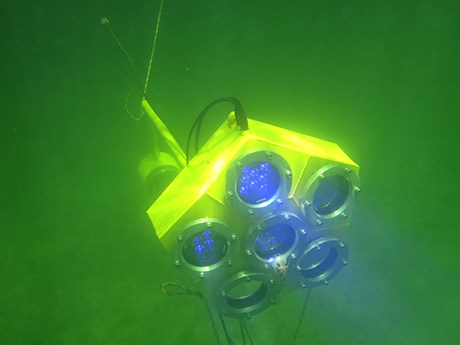A ground-breaking optical communication system developed by Sudbury-based Penguin Automated Systems Inc. is turning heads in the mining industry and attracting the attention of the military.
Greg Baiden, chairman and chief technology officer of Penguin, began experimenting with optical communication systems several years ago to remotely control a submersible under one of Sudbury’s lakes.
“When I started to work on this, it was to replace WiFi,” said Baiden. “What happens with WiFi is that when you (move) away from the antenna, the data rates drop exponentially. You can start off with 108 megabits per second, but as you move away, you eventually drop down to 2 megabits or less.
“If you want to control machines and need full broadcast video and real time control with joysticks, you can’t do it with 2 megabits.”
Radio communication isn’t an option because governments control radio frequencies and limit the amount of bandwidth available to run robots. Autonomous robots can be used to minimize communication, but “when you get into difficult environments like the ocean or in a mine, you can’t take the operator out of the loop, so you need a new type of communication system that’s localized and allows you to have enough bandwidth.”
Solid-state optical transceivers, or light domes, used by Penguin contain 70 or more LEDs per plate and hold a 120-degree field of view. Data rates of 100 megabits per second are achieved with near zero latency.
“The transceivers are built in a lens fashion that takes the signals, gathers them and transmits them,” said Baiden. “The conical shape takes away the problem of the directionality of light and turns it into a communication system that allows you to flood an area like a cell phone tower.
“We can put them on robots so, as they move around, they’re always in coverage. It’s like there’s an aura of light about them. We can achieve extremely high bandwidths that will allow us to run multiple robots.
“They can go on vehicles that have their own power source, or we can use saltwater batteries to power freestanding transceivers and leave them in place in the ocean in a pattern that allows us to mine a particular area.”
An optical communication system would have come in handy in the 2010 Deepwater Horizon explosion and oil spill in the Gulf of Mexico, said Baiden, who is also a professor of robotics and mine automation at Laurentian University.
“They were trying to plug a hole eight kilometres under the ocean using three tethered robots working within 50 feet of each other. Imagine the pressure they were under.”
If the tethers got tangled up, they ran the risk of losing one or more robots worth hundreds of millions of dollars while the whole world was counting on them to cap a well that was spewing 4.9 million barrels of oil into the Gulf of Mexico.
“What we’ve done is develop an optical mesh network that eliminates tethers. We can anchor or suspend light domes in the ocean and power them using saltwater batteries can last from five to seven years,” said Baiden.
The system can also be used on surface by flooding an open pit with light and taking complete control of all the machines.
Baiden also hopes to test the technology on a stacker in Chile that Penguin ASI is converting for teleoperation. The huge piece of equipment transfers ore to a leach pad and is currently controlled by an operator who sits in a cab on top of the equipment. The idea is to relocate the operator to an air-conditioned telecommand centre and away from the acidic fumes and heat of the leach pad. The customer, Codelco, plans to use WiMAX, but also wants to test Penguin’s optical communication system, said Baiden.
“If you want to run a stacker, a bucketwheel excavator and spreader, you need 12 to 14 video channels per machine and wireless systems currently out there can’t handle that.”
Baiden also plans to use the system to control robots Penguin has developed to inspect hazardous stopes in underground operations and for mine rescue.
The armed forces are interested, too, because optical communication systems can potentially be used to control military assets on the battlefield.



